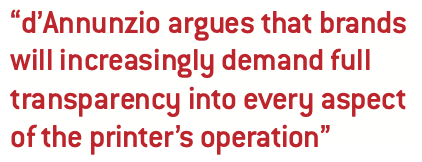The Andy Thomas-Emans column

Label Congress 2021 in Chicago and the answering panel sessions organized by Finat to give the European perspective, together represent a fascinating roadmap for the label industry.
We can break the discussions down into four broadly related areas: supply chain challenges – even beyond the pandemic; digitization of the workflow; automation, Big Data and the impact of Industry 4.0; and what kind of skills label converters will need from the next generation of print factory workers.
To start with supply chain challenges, panelists on both sides of the Atlantic agreed that while Covid-19 has generally boosted key sectors of the label business such as food, drink and pharma, it has also brought to the fore wider supply chain issues: shortage of key raw materials, HGV driver shortages, container blockages at ports.
These pressures (see also the fascinating feature by my colleague Luis Rodriguez on p58 of this issue) are not likely to go away even when Covid is finally defeated. What the panelists are seeing is not only increasing lead times for label consumables – which will inevitably feed through to longer lead times for customers – but also price increases across a range of consumables which are harder and harder to pass on.
 The discussion around digitization focused on the related topics of hybridization of print technologies and digital embellishment. Ultimately this promises to bring about a fully digitized label production line, including not only printing but also inkjet varnishing and tactile effects, metalizing/foiling and laser die-cutting. We are still some way from that, but the future trajectory of machine development is clear.
The discussion around digitization focused on the related topics of hybridization of print technologies and digital embellishment. Ultimately this promises to bring about a fully digitized label production line, including not only printing but also inkjet varnishing and tactile effects, metalizing/foiling and laser die-cutting. We are still some way from that, but the future trajectory of machine development is clear.
Hybrid presses are a step towards this ‘lights out’ press concept, and there were fascinating discussions about when it does – and does not – currently make sense to invest in digital print stations combined with manually-changed flexo, decoration and converting stations. Certainly a combination of increasing inkjet speed and print quality, fast change semi-rotary dies and increased flexo unit automation is helping make the hybrid proposition more streamlined and attractive.
Digital embellishment is rapidly establishing itself as a viable technology, and discussions ranged over both the advantages and challenges to be overcome. For example, tactile in-line inkjet varnishes are not anywhere near the high build achievable with a screen unit, so this is one area where hybrid remains the only option. But the ability to follow variable print with variable decorative effects such as spot varnishes and foils greatly expands the options open to designers.
Transform
Big Data was a key subject for discussion, with a unique intervention by industry visionary Federico d’Annunzio looking at how vast increases in computing power and networking speeds will transform not only the internal print factory, but also relationships with key outside stakeholders like global brand customers. d’Annunzio argues that brands will increasingly demand full transparency into every aspect of the printer’s operation.
The European panelists said so far they had not detected any such pressures from their customers, so it will be fascinating to see whether this develops as d’Annunzio foresees.
Within the print plant there are still major blockages to the free flow of data, particularly the closed operating systems of today’s conventional narrow and mid-web presses (MPS is the current exception). This means presses are unable to upload data or return production data in real time to factory management systems. Press automation, no matter how advanced, remains an ‘island’ in the connected factory.
Related to the Big Data discussion was data security. If we are now increasingly running our machinery through Industry 4.0 automated systems and exchanging high value files rather than physical artwork with branded goods customers, how can we guarantee the security of that data against malicious attacks? Answers might include blockchain and the sheer encryption power of future computing technologies like quantum computers.
Turning to what sort of skills the industry will require from the next generation of young workers, there was broad agreement that the trend towards digitization provides the industry with the chance to reinvent itself as a dynamic, tech-driven career path. There will simply be fewer and fewer operations involving heavy lifting and ‘industrial’ high noise or dirty environments, and more concentration on data handling and workflow.
Interestingly however, the young panelist in the US, still at print college, said what attracted her and fellow students to the industry was the chance to earn good money with good benefits in a safe and growing sector of employment, suggesting this might be a great message to get out to schools and colleges.
Label Congress conference recordings are available to Label Academy subscribers at www.labelsandlabeling.com/label-academy, while the Finat webinars are available to association members at www.finat.com
Stay up to date
Subscribe to the free Label News newsletter and receive the latest content every week. We'll never share your email address.


